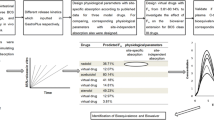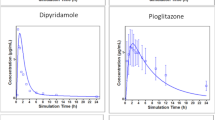Abstract
Drug solubility, effective permeability, and intestinal metabolism and transport are parameters that govern intestinal bioavailability and oral absorption. However, excipients may affect the systemic bioavailability of a drug by altering these parameters. Thus, parameter sensitivity analyses using physiologically based pharmacokinetic (PBPK) models were performed to examine the potential impact of excipients on oral drug absorption of different Biopharmaceutics Classification System (BCS) class drugs. The simulation results showed that changes in solubility had minimal impact on Cmax and AUC0-t of investigated BCS class 1 and 3 drugs. Changes in passive permeability altered Cmax more than AUC0-t for BCS class 1 drugs but were variable and drug-specific across different BCS class 2 and 3 drugs. Depending on the drug compounds for BCS class 1 and 2 drugs, changes in intestinal metabolic activity altered Cmax and AUC0-t. Reducing or increasing influx and efflux transporter activity might likely affect Cmax and AUC0-t of BCS class 2 and 3 drugs, but the magnitude may be drug dependent. Changes in passive permeability and/or transporter activity for BCS class 2 and 3 drugs might also have a significant impact on fraction absorbed and systemic bioavailability while changes in intestinal metabolic activity may have an impact on gut and systemic bioavailability. Overall, we demonstrate that PBPK modeling can be used routinely to examine sensitivity of bioavailability based on physiochemical and physiological factors and subsequently assess whether biowaiver requirements need consideration of excipient effects for immediate release oral solid dosage forms.






Similar content being viewed by others
References
Pond SM, Tozer TN. First-pass elimination. Basic concepts and clinical consequences. Clin Pharmacokinet. 1984;9(1):1–25. doi:10.2165/00003088-198409010-00001.
Benet LZ. The role of BCS (biopharmaceutics classification system) and BDDCS (biopharmaceutics drug disposition classification system) in drug development. J Pharm Sci. 2013;102(1):34–42. doi:10.1002/jps.23359.
U.S. Department of Health and Human Services, Food and Drug Administration, Center for Drug Evaluation and Research. Guidance for industry: waiver of in vivo bioavailability and bioequivalence studies for immediate-release solid oral dosage forms based on a biopharmaceutics classification system. http://www.fda.gov/downloads/Drugs/GuidanceComplianceRegulatoryInformation/Guidances/ucm070246.pdf. 2015.
Chen ML, Sadrieh N, Yu L. Impact of osmotically active excipients on bioavailability and bioequivalence of BCS class III drugs. AAPS J. 2013;15(4):1043–50. doi:10.1208/s12248-013-9509-z.
Shono Y, Nishihara H, Matsuda Y, Furukawa S, Okada N, Fujita T, et al. Modulation of intestinal P-glycoprotein function by cremophor EL and other surfactants by an in vitro diffusion chamber method using the isolated rat intestinal membranes. J Pharm Sci. 2004;93(4):877–85. doi:10.1002/jps.20017.
Johnson BM, Charman WN, Porter CJ. An in vitro examination of the impact of polyethylene glycol 400, Pluronic P85, and vitamin E d-alpha-tocopheryl polyethylene glycol 1000 succinate on P-glycoprotein efflux and enterocyte-based metabolism in excised rat intestine. AAPS PharmSci. 2002;4(4), E40. doi:10.1208/ps040440.
Rege BD, Kao JP, Polli JE. Effects of nonionic surfactants on membrane transporters in Caco-2 cell monolayers. Eur J Pharm Sci. 2002;16(4–5):237–46.
Hanke U, May K, Rozehnal V, Nagel S, Siegmund W, Weitschies W. Commonly used nonionic surfactants interact differently with the human efflux transporters ABCB1 (p-glycoprotein) and ABCC2 (MRP2). Eur J Pharm Biopharm. 2010;76(2):260–8. doi:10.1016/j.ejpb.2010.06.008.
Nozawa T, Toyobuku H, Kobayashi D, Kuruma K, Tsuji A, Tamai I. Enhanced intestinal absorption of drugs by activation of peptide transporter PEPT1 using proton-releasing polymer. J Pharm Sci. 2003;92(11):2208–16. doi:10.1002/jps.10491.
Takizawa Y, Kishimoto H, Nakagawa M, Sakamoto N, Tobe Y, Furuya T, et al. Effects of pharmaceutical excipients on membrane permeability in rat small intestine. Int J Pharm. 2013;453(2):363–70. doi:10.1016/j.ijpharm.2013.05.055.
Tayrouz Y, Ding R, Burhenne J, Riedel KD, Weiss J, Hoppe-Tichy T, et al. Pharmacokinetic and pharmaceutic interaction between digoxin and Cremophor RH40. Clin Pharmacol Ther. 2003;73(5):397–405.
Hetal PT, Jagruti LD. Influence of excipients on drug absorption via modulation of intestinal transporters activity. Asian J Pharm. 2015;9(2):69–82.
Martin-Facklam M, Burhenne J, Ding R, Fricker R, Mikus G, Walter-Sack I, et al. Dose-dependent increase of saquinavir bioavailability by the pharmaceutic aid cremophor EL. Br J Clin Pharmacol. 2002;53(6):576–81.
Wang HJ, Hsiong CH, Ho ST, Lin MJ, Shih TY, Huang PW, et al. Commonly used excipients modulate UDP-glucuronosyltransferase 2b7 activity to improve nalbuphine oral bioavailability in humans. Pharm Res. 2014;31(7):1676–88. doi:10.1007/s11095-013-1272-4.
Bogman K, Zysset Y, Degen L, Hopfgartner G, Gutmann H, Alsenz J, et al. P-glycoprotein and surfactants: effect on intestinal talinolol absorption. Clin Pharmacol Ther. 2005;77(1):24–32. doi:10.1016/j.clpt.2004.09.001.
Bischoff KB, Dedrick RL. Thiopental pharmacokinetics. J Pharm Sci. 1968;57(8):1346–51.
Fan J, Chen S, Chow EC, Pang KS. PBPK modeling of intestinal and liver enzymes and transporters in drug absorption and sequential metabolism. Curr Drug Metab. 2010;11(9):743–61.
Pang KS. Safety testing of metabolites: expectations and outcomes. Chem Biol Interact. 2009;179(1):45–59. doi:10.1016/j.cbi.2008.09.013.
Sun H, Pang KS. Disparity in intestine disposition between formed and preformed metabolites and implications: a theoretical study. Drug Metab Dispos. 2009;37(1):187–202. doi:10.1124/dmd.108.022483.
Jiang W, Kim S, Zhang X, Lionberger RA, Davit BM, Conner DP, et al. The role of predictive biopharmaceutical modeling and simulation in drug development and regulatory evaluation. Int J Pharm. 2011;418(2):151–60. doi:10.1016/j.ijpharm.2011.07.024.
Zhang X, Lionberger RA. Modeling and simulation of biopharmaceutical performance. Clin Pharmacol Ther. 2014;95(5):480–2. doi:10.1038/clpt.2014.40.
Zhang X, Lionberger RA, Davit BM, Yu LX. Utility of physiologically based absorption modeling in implementing Quality by Design in drug development. AAPS J. 2011;13(1):59–71. doi:10.1208/s12248-010-9250-9.
Darwich AS, Neuhoff S, Jamei M, Rostami-Hodjegan A. Interplay of metabolism and transport in determining oral drug absorption and gut wall metabolism: a simulation assessment using the "Advanced Dissolution, Absorption, Metabolism (ADAM)" model. Curr Drug Metab. 2010;11(9):716–29.
Yu LX, Amidon GL. A compartmental absorption and transit model for estimating oral drug absorption. Int J Pharm. 1999;186(2):119–25.
Lymperopoulos A, McCrink KA, Brill A. Impact of CYP2D6 Genetic Variation on the Response of the Cardiovascular Patient to Carvedilol and Metoprolol. Curr Drug Metab. 2015;17(1):30–6.
Wandel C, Bocker R, Bohrer H, Browne A, Rugheimer E, Martin E. Midazolam is metabolized by at least three different cytochrome P450 enzymes. Br J Anaesth. 1994;73(5):658–61.
de Lannoy IA, Silverman M. The MDR1 gene product, P-glycoprotein, mediates the transport of the cardiac glycoside, digoxin. Biochem Biophys Res Commun. 1992;189(1):551–7.
Fang J, Bourin M, Baker GB. Metabolism of risperidone to 9-hydroxyrisperidone by human cytochromes P450 2D6 and 3A4. Naunyn Schmiedeberg’s Arch Pharmacol. 1999;359(2):147–51.
Sousa M, Pozniak A, Boffito M. Pharmacokinetics and pharmacodynamics of drug interactions involving rifampicin, rifabutin and antimalarial drugs. J Antimicrob Chemother. 2008;62(5):872–8. doi:10.1093/jac/dkn330.
Zhang W, Yu BN, He YJ, Fan L, Li Q, Liu ZQ, et al. Role of BCRP 421C>A polymorphism on rosuvastatin pharmacokinetics in healthy Chinese males. Clin Chim Acta. 2006;373(1–2):99–103. doi:10.1016/j.cca.2006.05.010.
Shirasaka Y, Kuraoka E, Spahn-Langguth H, Nakanishi T, Langguth P, Tamai I. Species difference in the effect of grapefruit juice on intestinal absorption of talinolol between human and rat. J Pharmacol Exp Ther. 2010;332(1):181–9. doi:10.1124/jpet.109.159756.
Wenzel U, Gebert I, Weintraut H, Weber WM, Clauss W, Daniel H. Transport characteristics of differently charged cephalosporin antibiotics in oocytes expressing the cloned intestinal peptide transporter PepT1 and in human intestinal Caco-2 cells. J Pharmacol Exp Ther. 1996;277(2):831–9.
Kato R, Nishide M, Kozu C, Iwamoto A, Urashima K, Suzuki K, et al. Is cyclosporine A transport inhibited by pravastatin via multidrug resistant protein 2? Eur J Clin Pharmacol. 2010;66(2):153–8. doi:10.1007/s00228-009-0740-6.
Bergstrom CA, Andersson SB, Fagerberg JH, Ragnarsson G, Lindahl A. Is the full potential of the biopharmaceutics classification system reached? Eur J Pharm Sci. 2014;57:224–31. doi:10.1016/j.ejps.2013.09.010.
Kamble PR, Shaikh KS, Chaudhari PD. Application of liquisolid technology for enhancing solubility and dissolution of rosuvastatin. Adv Pharm Bull. 2014;4(2):197–204. doi:10.5681/apb.2014.029.
Anderberg EK, Artursson P. Epithelial transport of drugs in cell culture. VIII: Effects of sodium dodecyl sulfate on cell membrane and tight junction permeability in human intestinal epithelial (Caco-2) cells. J Pharm Sci. 1993;82(4):392–8.
Amidon GL, Lennernas H, Shah VP, Crison JR. A theoretical basis for a biopharmaceutic drug classification: the correlation of in vitro drug product dissolution and in vivo bioavailability. Pharm Res. 1995;12(3):413–20.
Tiwari G, Tiwari R, Rai AK. Cyclodextrins in delivery systems: applications. J Pharm Bioallied Sci. 2010;2(2):72–9. doi:10.4103/0975-7406.67003.
Thomas VH, Bhattachar S, Hitchingham L, Zocharski P, Naath M, Surendran N, et al. The road map to oral bioavailability: an industrial perspective. Expert Opin Drug Metab Toxicol. 2006;2(4):591–608. doi:10.1517/17425255.2.4.591.
Klaassen CD, Aleksunes LM. Xenobiotic, bile acid, and cholesterol transporters: function and regulation. Pharmacol Rev. 2010;62(1):1–96. doi:10.1124/pr.109.002014.
Chow EC, Pang KS. Why we need proper PBPK models to examine intestine and liver oral drug absorption. Curr Drug Metab. 2013;14(1):57–79.
Muller F, Fromm MF. Transporter-mediated drug-drug interactions. Pharmacogenomics. 2011;12(7):1017–37. doi:10.2217/pgs.11.44.
Koenen A, Kroemer HK, Grube M, Meyer zu Schwabedissen HE. Current understanding of hepatic and intestinal OATP-mediated drug-drug interactions. Expert Rev Clin Pharmacol. 2011;4(6):729–42. doi:10.1586/ecp.11.58.
Yu L, Bridgers A, Polli J, Vickers A, Long S, Roy A, et al. Vitamin E-TPGS increases absorption flux of an HIV protease inhibitor by enhancing its solubility and permeability. Pharm Res. 1999;16(12):1812–7.
Dhanaraju MD, Kumaran KS, Baskaran T, Moorthy MS. Enhancement of bioavailability of griseofulvin by its complexation with beta-cyclodextrin. Drug Dev Ind Pharm. 1998;24(6):583–7. doi:10.3109/03639049809085663.
Annex 7. Multisource (generic) pharmaceutical products: guidelines on registration requirements to establish interchangeability. 2006. WHO Technical Report Series, No. 937; pp. 347–390.
Sinko PJ, Lee YH, Makhey V, Leesman GD, Sutyak JP, Yu H, et al. Biopharmaceutical approaches for developing and assessing oral peptide delivery strategies and systems: in vitro permeability and in vivo oral absorption of salmon calcitonin (sCT). Pharm Res. 1999;16(4):527–33.
Dodane V, Amin Khan M, Merwin JR. Effect of chitosan on epithelial permeability and structure. Int J Pharm. 1999;182(1):21–32.
Tompkins L, Lynch C, Haidar S, Polli J, Wang H. Effects of commonly used excipients on the expression of CYP3A4 in colon and liver cells. Pharm Res. 2010;27(8):1703–12. doi:10.1007/s11095-010-0170-2.
Engel A, Oswald S, Siegmund W, Keiser M. Pharmaceutical excipients influence the function of human uptake transporting proteins. Mol Pharm. 2012;9(9):2577–81. doi:10.1021/mp3001815.
Irie M, Terada T, Katsura T, Matsuoka S, Inui K. Computational modelling of H+−coupled peptide transport via human PEPT1. J Physiol. 2005;565(Pt 2):429–39. doi:10.1113/jphysiol.2005.084582.
Acknowledgments
The authors would like to thank Dr. Peng Zou (FDA) for discussion and providing comments on this project.
Author information
Authors and Affiliations
Corresponding author
Additional information
Guest Editor: Peng Zou
Disclaimer
The views expressed in this article are those of the authors and not necessarily those of the Food and Drug Administration (FDA).
Electronic supplementary material
Below is the link to the electronic supplementary material.
ESM 1
(DOC 1513 kb)
Rights and permissions
About this article
Cite this article
Chow, E.C.Y., Talattof, A., Tsakalozou, E. et al. Using Physiologically Based Pharmacokinetic (PBPK) Modeling to Evaluate the Impact of Pharmaceutical Excipients on Oral Drug Absorption: Sensitivity Analyses. AAPS J 18, 1500–1511 (2016). https://doi.org/10.1208/s12248-016-9964-4
Received:
Accepted:
Published:
Issue Date:
DOI: https://doi.org/10.1208/s12248-016-9964-4




